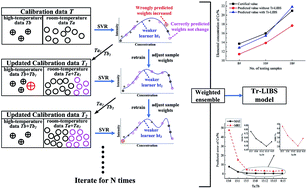An LIBS quantitative analysis method for alloy steel at high temperature based on transfer learning
Abstract
The analysis accuracy of laser-induced breakdown spectroscopy (LIBS) in high temperature applications will decrease when certified standard samples used for building calibration curves are insufficient. A novel LIBS quantitative method based on transfer learning is proposed, in which information on the spectra at room temperature is transferred to the spectra at high temperature in order to assist in building a better regression model. An iterative weight adjusting scheme is used for different samples in model training and the concept of ensemble learning is involved when the results of testing samples are predicted. Experiments on certified alloy steel standard samples were conducted to analyze Cr concentrations. The calibration dataset consisted of 15 standard samples at room temperature and 4 standard samples at high temperature. Another 3 samples at high temperature were used for testing. The results showed that the average absolute and relative errors of 3 testing samples were reduced by 1.8% and 20.58%, respectively. The proposed method provides a feasible way for LIBS analysis of samples at high temperature with lower cost and enhances the potentiality of LIBS in online industrial measurement in high temperature production processes, such as iron and steel smelting.



 Please wait while we load your content...
Please wait while we load your content...